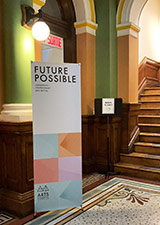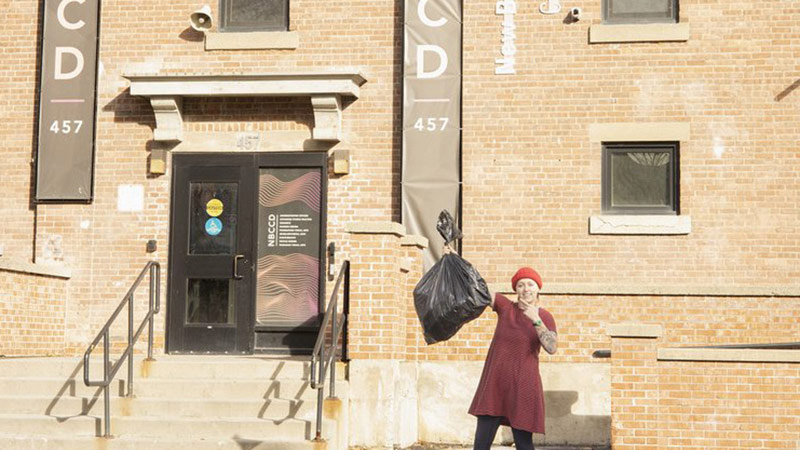Where sustainability meets design: An internship with the New Brunswick College of Craft and Design
Author: Angela Perdue
Posted on Mar 25, 2025
Category: Faculty of Forestry and Env Mgt
Beginning the internship
When I first joined the Master of Environmental Management (MEM) program at the University of New Brunswick, I knew I was bringing an unconventional background to the table—with a Bachelor of Architectural Studies and a work history spanning from tree planting to design firms, I wasn’t sure how my past experiences would fit into this new field. But what I quickly realized was that my design background wasn’t just relevant—it was a perfect complement to environmental management.
That became even clearer during my internship.
I applied for this position because I genuinely wanted to work at the New Brunswick College of Craft and Design (NBCCD). With my strong interest in design, it felt like the perfect place to bridge my background with my growing expertise in sustainability. I knew my past work in the community would help me stand out.
At the beginning of my MEM program, I started a social initiative focused on community-driven sustainability, which aligned with NBCCD’s increasing focus on sustainability in the arts. As it turned out, the MEM program and NBCCD had a lot more in common than I expected, and soon, I stepped into the role of Sustainability Coordinator at the college.

From day one, I felt at home. Unlike larger post-secondary institutions, NBCCD’s small, tight-knit environment meant that my work had an immediate impact. Faculty, staff, and students were naturally curious about my new role, often asking, “What does sustainability look like in a college focused on craft and design?” That curiosity sparked some great conversations—and set the foundation for the work ahead.
Diving into sustainability at NBCCD
Those early conversations quickly turned into action. In my first week, I had the opportunity to introduce myself at the faculty retreat, where I gave a joint presentation on the school’s evolving values around sustainability.
Our focus wasn’t just on “sustainability” in the traditional sense but on regenerative design—a concept that goes beyond reducing harm and instead focuses on actively restoring and improving environmental and social systems.
I challenged faculty members to consider how regenerative design principles could be woven into their own creative disciplines, whether that be pottery, metalworking, textiles, or other craft-based arts. The response was exciting—faculty members were eager to explore how these ideas could be incorporated into their curricula.
A major part of my internship also involved aligning NBCCD’s values with the United Nations' Sustainable Development Goals (SDGs). Before we could take action, we needed to ensure that faculty and staff understood what the SDGs were and how they could be applied in an arts-focused institution.
Through education and collaboration, we reached a major milestone—NBCCD officially signed the SDG pledge, committing to sustainability at an institutional level. Our SDG initiatives.
A highlight: The future possible conference

One of the most memorable moments of my internship was attending the Future Possible Conference in Saint John, NB. I had the chance to represent NBCCD and speak about the intersection of sustainability, design and the arts.
The conference was an incredible learning experience—a dynamic exchange of ideas where artists, designers, and sustainability professionals shared their perspectives and challenged each other’s ways of thinking.
Being able to discuss regenerative design in this setting allowed me to connect my interests in architecture, design, and environmental management in a really meaningful way.
Lessons from the experience
This internship wasn’t just about sustainability—it was about leadership, communication, and strategy. Over the course of several months, I developed skills in goal setting, long-term project planning and public speaking. Presenting to faculty, speaking at conferences, and engaging in strategic planning all pushed me outside my comfort zone in the best way possible.
One of the most rewarding parts of the experience was receiving positive feedback on my presentations. Being able to communicate ideas that I truly care about—and seeing them resonate with others—was incredibly validating.
Beyond skill-building, this experience reinforced something important: interdisciplinary knowledge is key in sustainability. My background in design didn’t just fit into the world of environmental management—it added value in unexpected ways. Seeing how these fields could work together so seamlessly has given me confidence in the opportunities that lie ahead.
How to land a meaningful internship
For those of you looking for an internship, my biggest piece of advice is this: embrace your local network. Opportunities don’t always come from where you expect them, and sometimes, the impact you have on a small group can lead to something much bigger.
For me, this internship was a full-circle moment. It brought together my past experiences in architectural design and my growing expertise in environmental management in a way that felt incredibly natural. I couldn’t have asked for a better experience.
A huge thank you to NBCCD for welcoming me and to the University of New Brunswick’s MEM program for paving the way. This internship has shown me just how much potential there is at the intersection of sustainability and design—and I can’t wait to explore it further.

